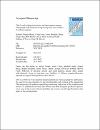Levels of physical activity and sleep patterns among older people with dementia living in long-term care facilities: A 24-hour snapshot
| المؤلف | Moyle, Wendy |
| المؤلف | Jones, Cindy |
| المؤلف | Murfield, Jenny |
| المؤلف | Draper, Brian |
| المؤلف | Beattie, Elizabeth |
| المؤلف | Shum, David |
| المؤلف | Thalib, Lukman |
| المؤلف | O'Dwyer, Siobhan |
| المؤلف | Mervin, Cindy M. |
| تاريخ الإتاحة | 2017-06-04T07:01:16Z |
| تاريخ النشر | 2017 |
| اسم المنشور | Maturitas |
| المعرّف | http://dx.doi.org/10.1016/j.maturitas.2017.05.015 |
| الاقتباس | Wendy Moyle, Cindy Jones, Jenny Murfield, Brian Draper, Elizabeth Beattie, David Shum, Lukman Thalib, Siobhan O’Dwyer, Cindy M. Mervin, Levels of physical activity and sleep patterns among older people with dementia living in long-term care facilities: A 24-hour snapshot, Maturitas, Available online 30 May 2017 |
| الرقم المعياري الدولي للكتاب | 0378-5122 |
| الملخص | Objectives To objectively measure over a 24-hour period the daytime and nighttime levels of physical activity and sleep patterns of older people with dementia living in long-term care facilities. Study design Nested within a larger research program, this cross-sectional study involved 415 residents, aged ≥60 years, with a documented diagnosis of dementia, from 28 long-term care facilities in south-east Queensland, Australia. Main outcome measures Residents wore SenseWear® activity armbands continuously for 24 hours, with data recorded for: step count; total energy expenditure; metabolic equivalent of task (MET); and the amount of time spent physically active, lying down, awake and asleep. Residents’ levels of cognitive impairment (assessed using the Rowland Universal Dementia Assessment Scale) and agitation (assessed using the Cohen-Mansfield Agitation Inventory-Short Form), and demographic data were also collected. Results From a total of 415 residents monitored with the SenseWear® activity armbands, 192 met the valid wear-time of 21 hours or more, and had activity and sleep data recorded. These residents were largely inactive during the daytime (engaged in an average of 1.8 hours of light physical activity), but achieved recommended amounts of sleep at night (average of 6.8 hours). There was considerable variation within the sample, and activity and sleep differed by sex (p<.001), age (p=.010), mobility (p<.001), and antipsychotic usage (p=.030). Conclusions These data can be used by long-term care clinicians to assist in planning interventions and care approaches which promote physical activity and good sleep practices, and are individualized to physical and cognitive capabilities. Australian New Zealand Clinical Trials Registry (ACTRN12614000508673). |
| راعي المشروع | NHMRC |
| اللغة | en |
| الناشر | Elsevier |
| الموضوع | Activity monitor Cognitive impairment Cross-sectional Long-term care Older adults SenseWear® |
| النوع | Article |
تحقق من خيارات الوصول
الملفات في هذه التسجيلة
هذه التسجيلة تظهر في المجموعات التالية
-
الصحة العامة [515 items ]



